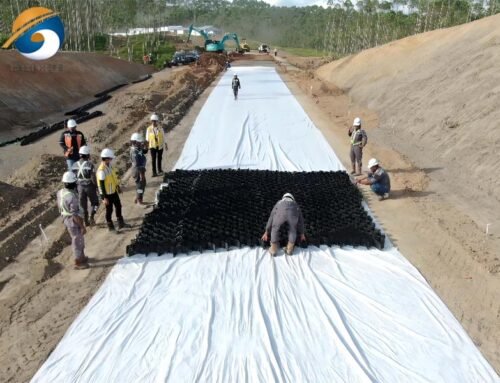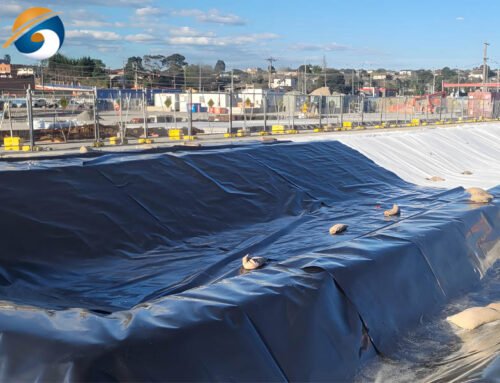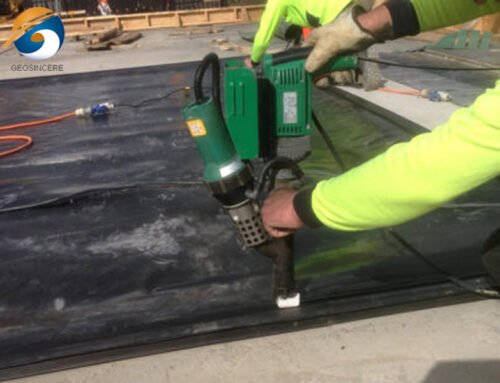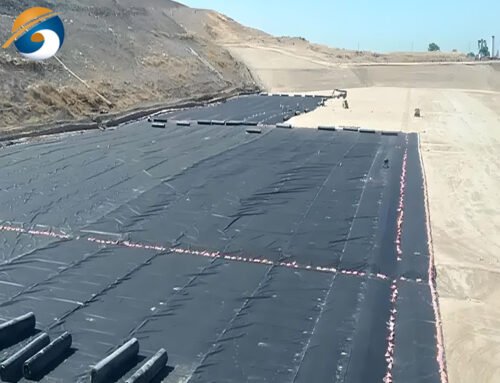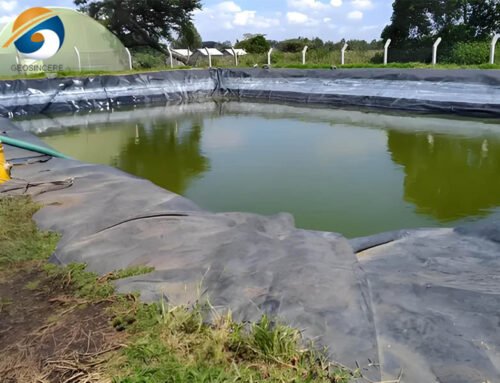Geocell vs geogrid, what are the similarities and differences? How to choose geocell and geogrid for soil stabilization, erosion control, and reinforcement in civil engineering projects? Is geocell better than geogrid for soft soil stabilization projects? These are the frequently asked questions when choosing between geocell and geogrid. Shandong GEOSINCERE New Materials Co., Ltd is the leading geosynthetics manufacturer and supplier, we wholesale complete line of geosynthetics products including geommebrane, geotextile, geocell, georid, and more. In this article, let’s explore and compare the geocell vs geogrid.
1. Intruduction of Geocell and Geogrid
1.1 What Is A Geocell?
A Geocell features three-dimensional honeycomb structures, offering cost-effective and dependable solutions for slope stabilization and load support.
In contemporary construction, foundations often incorporate HDPE geocell, seamlessly ultrasonically welded into a honeycomb configuration. These geocell products exhibit flexibility, allowing for convenient folding during transport.
There are two primary types of geocells: perforated and non-perforated. Perforated geocells enable natural drainage throughout the structure, promoting superior stress distribution. On the other hand, non-perforated geocells feature smooth solid walls and can be integrated with traditional drainage systems. GEOSINCERE’s innovative and high-quality geocell slope protection products are typically perforated, offering optimal drainage and stress distribution. Custom-designed HDPE geocell can also be provided to accommodate existing water systems as needed.
1.2 What is A Geogrid?
Geogrid, also known as geogrid mesh or plastic stabilization mesh, is a type of geosynthetic material used to provide stabilization and reinforcement to soils and similar materials. Derived from polymer plastics, typically polypropylene, polyethylene, or polyester, geogrid is composed of a network of interlocking vertical and horizontal ribs that form apertures (open spaces) in a grid arrangement. This often results in a pattern of square holes, resembling a sturdy plastic netting. Primarily designed for reinforcement applications in diverse construction projects, geogrids can also be utilized for separation purposes. These open grids facilitate the passage of soil through the apertures, and the interlocking of the two materials creates composite behavior. Plastic geogrid fabric is highly sought after in the construction industry due to their excellent tensile strength and capacity to efficiently distribute loads over a large surface area.
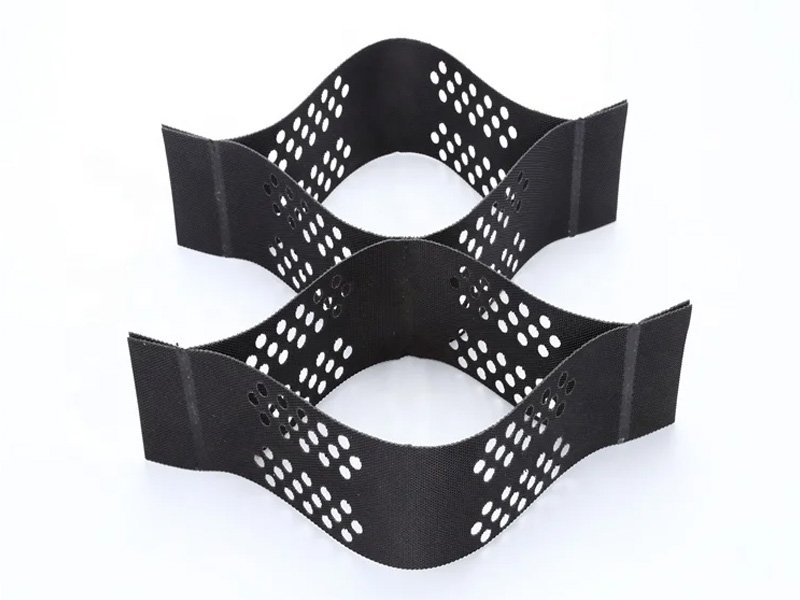

2 What are Similarities of Geocell and Geogrid
2.1 Raw Material of Geocell and Geogrid
Both geocells and geogrids are crafted from polymer composite materials. Polymer composite materials exhibit outstanding properties, including exceptional strength, robust load-bearing capacity, minimal deformation, low creep, corrosion resistance, substantial friction coefficient, prolonged lifespan, and convenient, rapid construction. These materials are widely used in a range of fields such as highway and railway construction, bridge abutments, approach structures, wharves, dams, slag fields, and soft soil foundation reinforcement. Due to their advantageous characteristics, they are also employed in retaining wall construction and pavement crack engineering. GEOSINCERE assures the use of premium-quality raw materials, all of which undergo rigorous testing and hold various specialized certifications to meet the highest standards.
2.2 Some Common Features of Geocell and Geogrid
Geocell and geogrid share several desirable qualities, including high strength, robust bearing capacity, minimal deformation, low creep, corrosion resistance, excellent friction coefficient, long service life, and convenient construction. These characteristics make them reliable and efficient solutions for various geotechnical applications. Geocells provide structural reinforcement by confining granular materials within their interconnected cells, enhancing load distribution and stability. Geogrids, on the other hand, offer tensile strength and soil confinement, improving the overall performance of soil structures. Both geocells and geogrids contribute to the longevity and effectiveness of projects such as soil stabilization, slope protection, retaining wall construction, and pavement reinforcement.
2.3 Some Common Applications
Geocell and geogrid are cutting-edge geotechnical materials renowned for their excellent aperture stability and impressive flexural rigidity. These geosynthetic materials hold significant importance in the geotechnical industry, particularly for reinforcing road foundations and ensuring road stability. Geocell provides a three-dimensional confinement system that enhances load distribution and prevents lateral movement of soil particles, resulting in improved road performance and durability. Geogrid, on the other hand, offers high tensile strength and soil reinforcement, effectively increasing the load-bearing capacity of road structures. Both geocell and geogrid contribute to safer and more reliable road infrastructure, minimizing deformations, preventing rutting, and extending the lifespan of road networks.
3 What are Differences of Geocell vs Geogrid
Despite sharing the common goal of improving infrastructure, these materials differ in terms of product structure, material properties, specific project applications, and compatibility with various soil strengths. But there have the distinct characteristics and applications of geocells vs geogrids in the filed of geotechnical materials. The following is a detailed comparison between geocells vs geogrids.
3.1 Different Structures of Geocell vs Geogrid
A geocell features a three-dimensional mesh surface of interconnected honeycomb structures, resembling a non-collapsible honeycomb. This configuration forms a thin layer of pocket-like cells, strategically designed to secure the chosen fill material. From a practical standpoint, the inherent honeycomb design of geocells provides robust support for various fill materials. Over the long term, these outcomes contribute significantly to minimizing climate disruption, preventing material compaction or movement. In this context, geocells also facilitate the unimpeded flow of water near the fill, avoiding constraints typically associated with compacted materials and allowing for widespread drainage.
In contrast, a geogrid operates within a two-dimensional framework. Their fundamental design is oriented toward preventing the movement of soil and other granular materials, whether positioned beneath sidewalks to mitigate the impact of dynamic loads or situated behind retaining walls to alleviate pressure on them. This objective is accomplished through the use of apertures, allowing material placed atop the geogrid to permeate and establish interlocking pockets between the high-tensile ribs. This configuration essentially generates a composite material that exhibits enhanced cohesion, distributing weight more uniformly. This characteristic is particularly beneficial in averting structural failure or damage to the base material and roadbed caused by concentrated loads. Geogrids are further categorized into one-way geogrid, two-way geogrid, steel-plastic reinforced geogrid, and fiberglass geogrid, offering diverse options for varied engineering applications.


3.2 Different Applications of Geocells vs Geogrid
3.2.1 Geocell Applications
Geocells have a variety of residential and commercial applications. Some common applications include road construction, slope protection, erosion control and retaining wall.
- Geocell for Road Construction. This is the most common and original application. Whether you are developing a highway, a forest road or a temporary road on a slope, geocell systems can effectively protect and stabilize the road. Geocell for road construction can combine good load distribution, reliability and stability with economy.
- Geocell for Slope Protection. Another common application is geocell for slope protection. Geocell is the ideal and economical geosynthetic material to stabilize steep slopes. The load geocell for slope protection provides excellent load distribution to ensure no areas of the slope bears excessive weight.
- Geocell Slope Erosion Control. Geocell slope erosion control is the most common uses. Mitigating water and wind erosion on slopes extends beyond the slopes alone, encompassing the protection of homes, businesses, and individuals both on and off the hill who could be impacted by slope collapse. Geocell systems act as highly efficient erosion control measures for slopes and shorelines. Irrespective of the slope’s gradient, geocells prove effective in thwarting erosion, providing a robust solution for safeguarding against potential environmental hazards.
- Geocell Retaining Wall. Geocell retaining wall designs excel as robust foundations for retaining walls, offering unparalleled strength, efficient load distribution, and flexibility in fill options. Regardless of the soil’s softness, the steepness of the slope, or the scale of the project, geocells demonstrate the capability to support a retaining wall for 75 years or more. Developers and engineers widely employ geocell products for various types of retaining walls, including gravity walls, MSE (Mechanically Stabilized Earth) walls, and even cantilever walls. The versatility and durability of geocell solutions make them a preferred choice for a range of retaining wall applications.
- Geocell structures can also serve as an effective substrate for parking lots. Developers can utilize geocells in gravel lots to ensure proper support and prevent rutting issues, or in paved lots to reduce costs and drainage issues.
3.2.2 Geogrid Applications
Geogrids are most commonly used in a variety of applications in construction, landscaping, and landscaping projects. These tend to fall into one of two categories: ground stabilization and reinforcement or slope stabilization and reinforcement.
Base stabilization geogrid is typically deployed for three reasons:
- Provide a solid working surface: Installing geogrids can improve the strength of soft subgrade soil and provide a solid foundation for your construction.
- Extend service life.Reduce structural cross-section Traditionally, roads need to be built on thicker foundations to increase their stiffness and stability to resist the loads they bear. However, doing so is expensive and time-consuming. Reinforcing soil with geogrids reduces the thickness of the foundation required to achieve the same level of stability, thereby reducing time and material costs while also increasing the lifespan of the building.
- Geogrids can be used to stabilize and strengthen yards, walkways, driveways and roads.
Geogrid for slope stabilization. In slope stabilization projects, geogrids are often deployed to improve the structural integrity of soil backfill and prevent sliding on steep embankments. One of the most common applications for geogrid slope reinforcement is in the construction of retaining walls. The use of geogrids to hold the soil backfill together and reinforce it will help prevent any ground movement behind and subsequent forces exerted on the retaining wall.

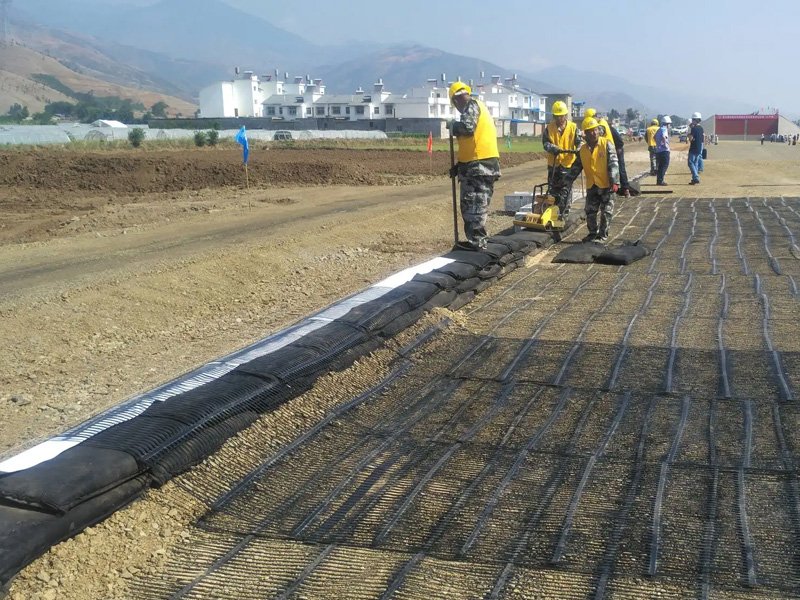
3.3 Geocells Outperforms Geogrids for Soft Foundation
3.3.1 Geogrids are difficult to install in soft subgrades
Geogrids rely on rutting, displacement and lateral movement of the road material to activate the load support reaction of the product. failure of the driving surface must occur before the geogrid reacts. As a result, rutting and soil displacement is a prerequisite reality to the system. Since the geogrid is two-dimensional, material not located directly within the plane occupied by the geogrid is free to move, shift and displace.
It is essential that geogrids are placed in a flat or a pre-tensioned manner—but that is not practical in a construction environment. It is common to see geogrids unrolled over a prepared grade with an undulating surface. As aggregate is placed over the top of the geogrid, the material kinks and waves, further warping the 2D plane. The geogrid is rarely pulled tight during installation which does not allow full tension under load.
In cases where subgrade is particularly poor, over-saturated, or already damaged by rutting, geogrids are even more difficult to place flat and tight as recommended. Soft subbase does not support medium or heavy construction equipment to place and spread the base layer over the geogrid without deforming the geogrid even further. The overall deformation creates an uneven geogrid layer that is poorly suited to function as intended.
Manufacturers of geogrids often recommend the use of two or even three layers to establish a reinforced aggregate cross-section, enhancing the load support capabilities of the geogrid. While this approach improves performance, it comes with the drawback of being time-intensive, requiring the unfurling, covering, and compaction of each layer separately. The installation and material costs proportionally increase, doubling or tripling with the incorporation of additional layers.
Geogrids face challenges in performing optimally on soft subgrades due to the difficulty in properly installing the thin, flexible material. Achieving the necessary flat and taut placement of the geogrid is challenging on less-than-ideal roadbeds. Moreover, to withstand substantial loads such as vehicular traffic, there may be a requirement to stack 2 or 3 layers of geogrids to attain the desired effect. Consequently, the overall project cost escalates with the number of layers needed for reinforcement.
3.3.2 Geocells are ideal for installation over soft soils
Expanding geocell sections doesn’t require any specialized equipment, making them suitable for placement over soft subbases without the need for low-pressure equipment to infill the cells. The process involves backing up fully loaded dump trucks, unloading the payload, and spreading the granular material into and over the geocell.
The robust vertical support provided by each cell reduces the likelihood of bending and sinking into the subgrade over time. This structural integrity not only contributes to enhanced long-term performance but also simplifies the installation process—geocells can be effortlessly unfurled in position and filled with substrate.
In the context of roads or other load-bearing surfaces, this approach proves to be a cost-effective and time-saving solution in the long run. The unparalleled support provided to the underside of the road minimizes shifts, subsequently reducing the occurrence of road damage over time.
3.4 Table of Key Differences for Geocells vs Geogrid
| No | Item | Geocell | Geogrid |
|---|---|---|---|
| 1 | Product Structure | 3D mesh of honeycomb structures | 2D mesh |
| 2 | Application | Roads and parking lots, Slope protection, Erosion Control, Retaining wall | Ground stabilization, Reinforce slopes |
| 3 | Soft Foudation | More suitable for soft soil laying | More suitable for hard soil laying |
4 Conclusion
In this article, we explored some similarities of geogrid and geocell. And we also put more attention on the differences of geogrid vs geocell. Geocells is widely used for road construction, slope protection, erosion control and retaining wall and parking lots. Geogrid helps us when our project is soft soil reinforcement and road reinforcement foundation. At the same time, geocells are easier to lay reinforced foundations in soft soil. Geogrid is easier to lay and install on hard soil.
GEOSINCERE offers the best geogrid and geocell products with competitive factory price. We are working passionately for excellent products, solutions and services through our experience and expertise. Any other questions or inquiries, please contact us.
Thank you for reading.

